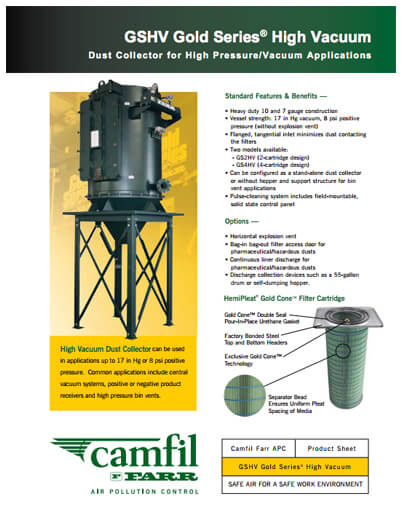Vortex and Venturi Wet Scrubbers
If your production processes produce hazardous particles,, Wet scrubbers safely remove them from the air. They are ideal for collecting:
- Combustible dust
- Flammable dust
- Aluminum magnesium chips
- Rubber, leather and plastic fines
- Fibrous textile dust
- Sticky powders
- Greasy vapors
- Carbon dust
Key Features:
- No filter elements
- Low maintenance
- Uses centrifugal force to remove pollutants from the air
Wet Scrubber Technology
Particles in the contaminated air stream are brought into contact with water in order to bind them and increase their weight and size. The centrifugal action of the wet scrubber separates these particle laden water droplets from the air stream, returning them to the base of the unit where the particles settle out and form a sludge. Camfil experts can help you select the best wet scrubber for your application.
Vortex: A compact and versatile multi-application use wet scrubber
The Vortex wet scrubber provides an efficient solution for managing sticky dust, fibers, and fluff. Operating on the water swirl principle, it introduces pollutant-laden air tangentially, creating an eddy sink on the water’s surface. The specially designed airflow generates a vigorous water swirl, which the polluted gas stream passes through. This intense mixing with the scrubbing fluid allows pollutants to bind and settle. A radial-mounted spiral then uses centrifugal force to separate the liquid and trapped pollutants from the gas stream. Finally, the cleaned air is drawn in by a downstream ventilator and expelled.

Venturi: A high-performance wet scrubber with robust design
The Venturi is the most commonly used, high efficiency wet scrubber for demanding applications with high dust loading. The system operates with an integrated ventilator, effectively separating pollutants from the air stream using a combination of water swirl and disintegration principles. Polluted air enters the middle section tangentially and is redirected to create a powerful water swirl. The contaminated gas is forced through this swirl, where ultra-fine particles are captured by the ventilator blades, which also act as disintegrators. Any remaining particles are thoroughly mixed with water and propelled by centrifugal force into a water wall, ensuring high separation efficiency. The wet particles then flow into the lower section of the unit, where they settle in the water-stilling zone. Finally, the cleaned gas exits through the central ventilation pipe.

 Americas
Americas 














